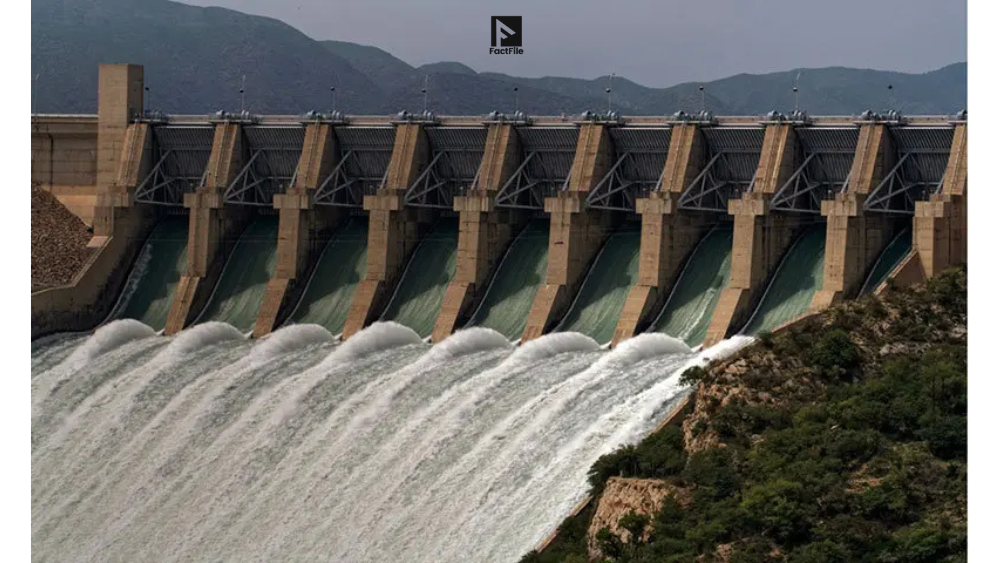The Water and Power Development Authority (WAPDA) confirmed on Thursday that Pakistan’s Largest Dam Reaches Full Capacity. Tarbela Dam, located on the Indus River, has achieved its maximum conservation level of 1,550 feet with a live storage capacity of 5.7268 million acre-feet (MAF). This milestone marks a significant achievement for Pakistan’s water management and power generation capabilities.
Tarbela Dam Storage Update
According to WAPDA’s spokesperson, the inflow of water from the Indus River into Tarbela Dam was recorded at 268,300 cusecs, while the outflow stood at 238,900 cusecs. With the reservoir now completely filled, Tarbela stands ready to support Pakistan’s irrigation and hydropower demands in the coming months.
The dam’s storage is crucial for maintaining water supplies during the dry season, while also contributing to flood regulation during monsoon peaks. By reaching full capacity, Tarbela is positioned to play a central role in both energy generation and food security.
Mangla Dam Water Levels
At the same time, Mangla Dam has also witnessed significant improvement in water levels. The reservoir has now reached 1,217.45 feet, which is about 74.5 percent of its maximum storage level of 1,242 feet. Mangla is currently holding 5.423 MAF of water.
Inflows from the Jhelum River were recorded at 38,600 cusecs, while the outflow remained at 7,000 cusecs. This strong inflow ensures a steady buildup of reserves, further enhancing the country’s overall water security.
Chashma Barrage Status
Meanwhile, Chashma Barrage reported an inflow of 403,500 cusecs and an outflow of 351,600 cusecs, with the reservoir storing 0.094 MAF of water. Chashma plays a critical role in regulating river flows and distributing water downstream to agricultural regions.

National Water Reserves
Combined, Pakistan’s water reserves now stand at 11.245 MAF, a robust level that provides much-needed relief for both irrigation and power generation sectors. These reserves are particularly vital for supporting agriculture, which remains the backbone of the national economy.
With rising population and climate variability placing increasing pressure on water resources, achieving this storage level marks a positive step toward meeting seasonal water demands.
Flood Situation Across Sindh and Punjab
The latest flood updates reveal varying conditions across the Indus River system.
- Guddu Barrage: High flood levels observed.
- Taunsa & Sukkur Barrages: Medium flood levels recorded.
- Kalabagh & Chashma: Low flood conditions.
- Kotri Barrage: Flows remain below the low flood threshold.
WAPDA and the Flood Forecasting Division are monitoring the situation closely to prevent risks to downstream communities. Controlled releases from Tarbela and Mangla are expected to balance the flow while minimizing flood threats.
Significance of Tarbela Reaching Full Capacity
The fact that Pakistan’s Largest Dam Reaches Full Capacity holds immense significance:
- Energy Security: Tarbela Dam generates hydropower that contributes thousands of megawatts to the national grid, reducing reliance on expensive thermal power.
- Irrigation Support: Stored water ensures adequate irrigation supplies for millions of acres of farmland during dry months, supporting crops such as wheat, rice, and cotton.
- Flood Management: Reservoirs at full capacity provide better regulation of river flows, reducing flood risk downstream.
- Economic Stability: A reliable water and energy supply strengthens agricultural productivity and industrial growth, directly impacting Pakistan’s economy.
Challenges Ahead
While full reservoirs are a positive development, experts caution that climate change continues to pose challenges for water security. Monsoon rainfall patterns are becoming increasingly unpredictable, making effective dam management more crucial than ever.
Authorities emphasize the need for:
- Building additional dams and reservoirs.
- Improving irrigation efficiency through modern techniques.
- Expanding hydropower projects to reduce energy shortages.
Looking Forward
Pakistan’s success in filling Tarbela, Mangla, and Chashma marks an encouraging sign at the height of the monsoon season. With total reserves at 11.245 MAF, the nation is in a stronger position to tackle agricultural, energy, and flood-related challenges.
ALSO READ: Gold prices drop in Pakistan after reaching record high
The achievement also highlights the importance of continued investment in water infrastructure. As demand for both water and power continues to rise, expanding storage capacity remains critical.





